The Nine Realms are a group of regions in mythical space that encompass Earth-1001, and is home to the Asgardians and a number of other races. Represented in physical space as nine planets connected by the cosmic nimbus Yggdrasil, The Nine Realms link various worlds from different realms, almost like a small multiverse in and of itself. While relatively small in a universal scale, The Nine Realms nontheless hold a very important role in governing the flow of events across The Multiverse. Despite having a physical representation in actual space, they are inaccessable by conventional means, requiring more mystical measures of travel, typically provided by the Bifrost.
The phrase "nine homeworlds" is Níu Heimar in Old Norse. Relating to another term heima meaning "home" or "homestead", the term heimr means a "place of abode" in the sense of a homeland or region, or in a larger sense a world.
Yggdrasil[]
The World Tree[]
Yggdrasil, the World Tree, is an energy field that supports and connects the Nine Realms. The roots and branches of the Tree each connect a different realm, chiefly through the Bifrost but can be achieved through other means by using the natural branch connections of Yggdrasil that support all the Nine Realms.
At its base are three wells: Urdarbrunnr (Well of Fate), from which the tree was watered by the Norns (the Fates); Hvergelmir (Roaring Kettle), in which dwelt Nidhogg, the monster that gnawed at the tree's roots; and Mímisbrunnr (Mimir's Well), source of wisdom. After Ragnarok, the World Tree, though badly shaken, was to be the source of new life.
While commonly described as a structure, most of the inhabitants of the Nine Realms believe Yggdrasil to be a living thing, a source of life for all creatures and beings that exist as part of it. This goes with the Asgardian belief that the Tree breathes with life and sways in the cosmic wind, bringing the Nine Realms closer together and farther apart at various intervals, cycling every 10,000 years.
The Convergence[]
Every 10,000 years when the branches of Yggdrasil come closest together, an event called The Convergence takes place. The branches are brought so close together that the Nine Realms essentially overlap and align, becoming closely adjacent to one another; the typical separation between the realms goes away, enabling free and easy travel between any and all of the Realms.
Asgard[]
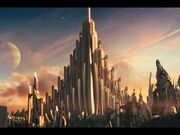
Asgard is the home of the Asgardians, sitting at the top of Yggdrasil.
It is a small, otherdimensional planetoid (its surface area being about the same as the continental United States), whose nature and physics are different from those of planetary bodies in the Earthly dimension. Asgard is not a sphere like the Earth, but a relatively flat landmass suspended in space. Asgard does not rotate about its axis, nor does it revolve around a sun. Asgard does have intervals of night and day (of undisclosed duration), so some object or force functions as a sun. There does, however, appear to be a form of seasonal cycle on Asgard.
Asgard's gravity apparently radiates from somewhere below it (assuming gravity works there as it does here): there is a "top" and a "bottom" to Asgard. At the edges of Asgard's landmass, a being or object can fall into a void, but some unknown force apparently keeps the edges themselves from eroding. The same force also prevents the bodies of water along Asgard's boundaries from pouring into the void and prevents Asgard's atmosphere from escaping. Asgard has been described as floating on a "Sea of Space." This sea apparently has a surface, one that is navigable by Asgardian ships, which resemble Viking longboats. The exact nature of space within the Asgardian dimension is unknown. While Asgard's gravity is roughly analogous to Earth's, common matter is considerably denser on average. For instance, a chair made of Asgardian wood is heavier and stronger than a chair made of Earthly wood. Rock, water, flesh, bone, steel: all matter is denser and thus more durable. Within Asgard lies the mystical region that is Valhalla, where the Asgardians, and certain mortals who prove themselves worthy in honor by glorifying themselves in battle, go upon their death.
With Ragnarok having come into completion, Asgard has ceased to exist.
Alfheim[]
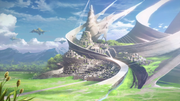
Alfheim, also known as Ljosalfheim, is the home of the Light Elves, sitting high on Yggdrasil underneath Asgard, next to Vanaheim, and above all the other realms.
Alfheim is as a kingdom of enchanted forests, candy vegetation, rivers and springs of wine, and beautiful gardens. The capital city of the realm is the castle stronghold of Ljosalfgard. Several tribes of Light Elves, Faeries, Pixies, and Mermaids inhabit various regions and climates of Alfheim along with magical fauna such as Unicorns, and winged cat steeds.
Vanaheim[]
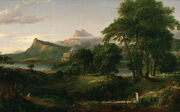
Vanaheim is the home of the Vanir, a sister race to the Asgardians, sitting high on Yggdrasil underneath Asgard, next to Alfheim, and above all the other realms.
The realm is filled with vast forests, fields and planes. It has become home to various other races such as Rock Trolls and Ogres. The realm is also filled with the ruins of gigantic castles mountain-sized and citadels, known as the "ruins of Vanaheim" or as the "Abandoned city of the Vanir".
Midgard[]
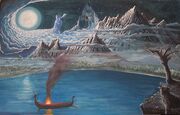
Midgard, also known as Terra or Gaia, is the home of the humans; Midgard is mostly regarded as Planet Earth. Midgard sits in the center of Yggdrasil, beneath Asgard, Vanaheim and Alfheim, adjacent to Jotunheim and Nidavellir, and above all other realms.
Midgard is Yggdrasil's strongest, most direct link to physical space. It is also home to many humans, villains, and is the access point for various aliens and other beings. The planet Earth has a varied climate, featuring a combination of the traits of the other realms including beautiful skies, vast oceans, sprawling cities, expansive forests, scorching deserts, crumbling rocklands, frozen tundras, hidden caverns, scorching firepits, and standing mountains.
Nidavellir[]
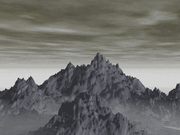
Nidavellir, also known as The Dark Fields, is the home of the Dwarves, sitting adjacent to Midgard across from Jotunheim, beneath Asgard, Vanaheim and Alfheim, and above all other realms.
The Dwarves live underground working in the caverns of the Nidavellir. They have large forgers utilizing the flames and heat from beneath the surface to create weapons used by the Dwarves and their allies. Dwarves are the race that have crafted the most powerful weapons in the Nine Realms. The nomadic Rock Trolls also inhabit some areas of this land.
Jotunheim[]
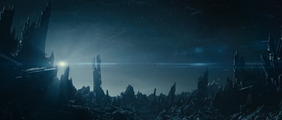
Jotunheim is the home of the Jotnar, also known as the Frost Giants or the Jotunn/Jotuns, sitting adjacent to Midgard across from Nidavellir, beneath Asgard, Vanaheim and Alfheim, and above all other realms.
Jotunheim is a cold and barren world of ice with very little sun light and perpetual winter.
Svartalfheim[]
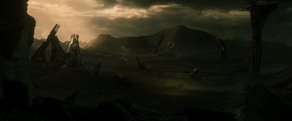
Svartalfheim, also known as Harudheen and The Dark World, is the home of the Dark Elves, sitting adjacent to Muspelheim, above Nifelheim, and beneath all other realms.
The geography and climate of the realm has been shown to be heavily wooded with Dark Elf towns, villages and castles dotting across the green rolling landscape. They have been shown to live both above ground in castles and underground in large caverns. The Dark Elves have their own portals that grants them access to some of the other Nine Worlds including Midgard.
Represented in physical space, Svartalfheim is located in a star system corroded almost entirely by dark matter, with its inhabitants, the Dark Elves, developing under a more diverse set of elements than our universe. The only source of illumination is light from the accretion of matter near the system's central black hole.
Muspelheim[]
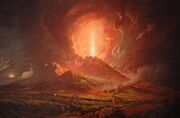
Muspelheim, also known as Muspel, is the home of the Eldjotnar/Fire Giants, sitting adjacent to Svartalfheim, above Nifelheim, and beneath all other realms.
Muspelheim is a realm of eternal fire, the home of various Fire-themed creatures, and is ruled by Surtur. The surface is rocky, covered in pools of lava and giant flame pits.
Represented in physical space, Muspelheim is a rocky, lava and flame-covered planetoid of a small size, and is a dyson sphere (hollow on the inside); within, there are expansive tunnels and caves leading to the central core of the planetoid, a massive cavern which is home to Surtur and his Fire Demons.
Niflheim[]
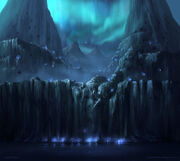
Niflheim, also known as Mist-Home, is a region of primordial ice and cold, located beneath all other realms.
Niflheim is a region of icy fogs and mists, darkness and cold. It is situated on the lowest level of the universe. The realm of death, Hel, is part of this vast, cold region, as is Nastrond, the Shore of Corpses across the Gjoll, where the the serpent Nidhogg eats corpses. Niffleheim lies beneath the third root of Yggdrasil, where the Nidhogg also gnaws on the roots of Yggdrasil close to the spring Hvergelmir.
With the end of Ragnarok, Niflheim has grown silent.
Hel[]
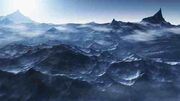
Hel, also known as Helheim, is part of Niflheim and is the realm of the dead. It is a place that the souls of those who are linked to Yggdrasil and the Nine Realm's following go when people die, unless they fall in glorious battle in which they are instead taken to Valhalla. It is not a place of punishment or torment, simply the underworld in which all souls go. Hel is ruled by Hela, the Goddess of Death.
History[]
The Nine Realms came into existence more than thousands of years ago; whether told by mythological stories or shaped by cosmological events, the existence of the Nine Realms nevertheless exist, at least rationally on an etherial plain connected to realspace while not being tangible to its physical inhabitants.
The highest of the Nine Realms, Asgard, has acted as a directory of order and stability; its inhabitants, the Asgardians, have pledged themselves to keep watch over all the Nine Realms and ensure that chaos is held back, violence is eschewed, and peace is maintained. As such, all the past and present Kings of Asgard are reknowned leaders in this effort, essentially ruling as the Lord of all the Nine Realms.
Not all of the inhabitants of the Nine Realms willingly went along with this, and as such various wars were fought across the Nine Realms, spanning periods of up to thousands of years to create the order and stability that exists between the realms now.
War with the Dark Elves[]
During the last Convergence, the Dark Elves, having achieved a significant technological breakthrough, began to seek glory in conquest. One military leader in particular, Malekith the Accursed, sought after the Aether in order to use its reality warping power to return the universe to its ancient, former state of darkness. Malekith's army managed to acquire the Aether and prepared to use it upon the beginning of the Convergence; however, the army of Asgard arrived at Svartalfheim to stop them. Led by King Bor, Son of Buri, the Asgardians managed to hold Malekith's army at bay long enough to witness the end of the Convergence. Seeing his forces defeated, Malekith sacrificed the majority of what remained of his army to try to take down Asgard with them, slipping away in darkness with a few of his chosen to try their plan out again during the next Convergence.
While many Asgardians had fallen from the conflict, they were ultimately victorious and had secured peace for a time. The Asgardians, seeing the Aether's potential to cause Ragnarok, took the artifact from Svartalfheim and locked it away in Bor's vault. Bor then further punished the Dark Elves for their ambition and took away their technology, dooming them to resume their former lives in villages while resorting to hunting and gathering.
Conquering the Nine Realms[]
Bor, enduring various other wars and conquests against the enemies of Asgard within the Nine Realms, finally initiated a conquest of the Nine Realms to reign them under control and begin an age of permanent peace, through force.
Rise of Odin[]
After Bor's falling in battle, his son, Odin, took the mantle of King, and initially continued this same conquest; however, shortly after he realized the potential of this war instigating Ragnarok; he saw the error in his and his father's way, and instead attempted a more peaceful solution, promising the Nine Realms he would seek to end the conquest with compassion. It took him time to get this to work, and he was forced to continue the war for a while, but eventually the Nine Realms agreed to a ceasefire, where the leaders all came together on Midgard and signed a pact to instigate a period of peace, where they could settle their disputes through diplomacy instead of bloodshed.
Skirmishes across the Nine Realms[]
As this peace continued, the Asgardians under Odin's rule only had to deal with small conflicts instead of open war, though they did have to contend with leaders who were unsatisfied by the constraints of life under Asgard's watch.
Invasion of the Frost Giants[]
One of these skirmishes, initiated by King Laufey of Jotunheim, involved the Frost Giants attempting to take over Midgard by using their source of power and life, The Casket of Ancient Winters, to attempt to plunge Midgard into a new, permanent Ice Age.
Odin, seeing the threat to the humans on Earth and the potential instability as a result, gathered his army and rallied to Midgard's defense, meeting Laufey and the Frost Giants in battle. Though the conflict was vicious and bloody, seeing the deaths of many on both sides, the Asgardians ultimately proved victorious, and drove the Frost Giants from Midgard back to Jotunheim.
Odin pursued the Frost Giants to their home in Jotunheim to ensure they would not try to invade Midgard again, and would understand Odin's rule and the consequences of challenging it; the Asgardians attacked the Frost Giants, and Odin met Laufey in personal combat. Their lengthy duel resulted in both receiving wounds, most notably the loss of Odin's right eye; however, Odin came out as the victor, and soon the Asgardian army defeated the Frost Giants and forced them to surrender.
Deeply regreting the bloody nature of the skirmish and subsequent invasion of the Frost Giant's home, Odin then formed a pact with the Frost Giants, swearing to never again attack Jotunheim with Laufey agreeing to keep his army on Jotunheim and never again attempt to conquer another realm. Shortly before departing, Odin discovered a lone, abandoned infant, a son of Laufey who was discarded due to his small size; unable to leave the child there alone, Odin took the child back to Asgard with him in secret, and only told his wife Frigga of the child's nature, never revealing his true identity to the child or anyone else. Raising him as an Asgardian with the help of Frigga's magic disguising the child, Odin took him as his adopted son and named him Loki.
===Return of the Dark Elves (wip)===